Reduce injury risk by following this guide on how to set your cycling cleat position
Riding clipped in can be more comfortable and enhance your performance - providing you’ve set your cleats up correctly. Here’s our expert guide on how to do just that
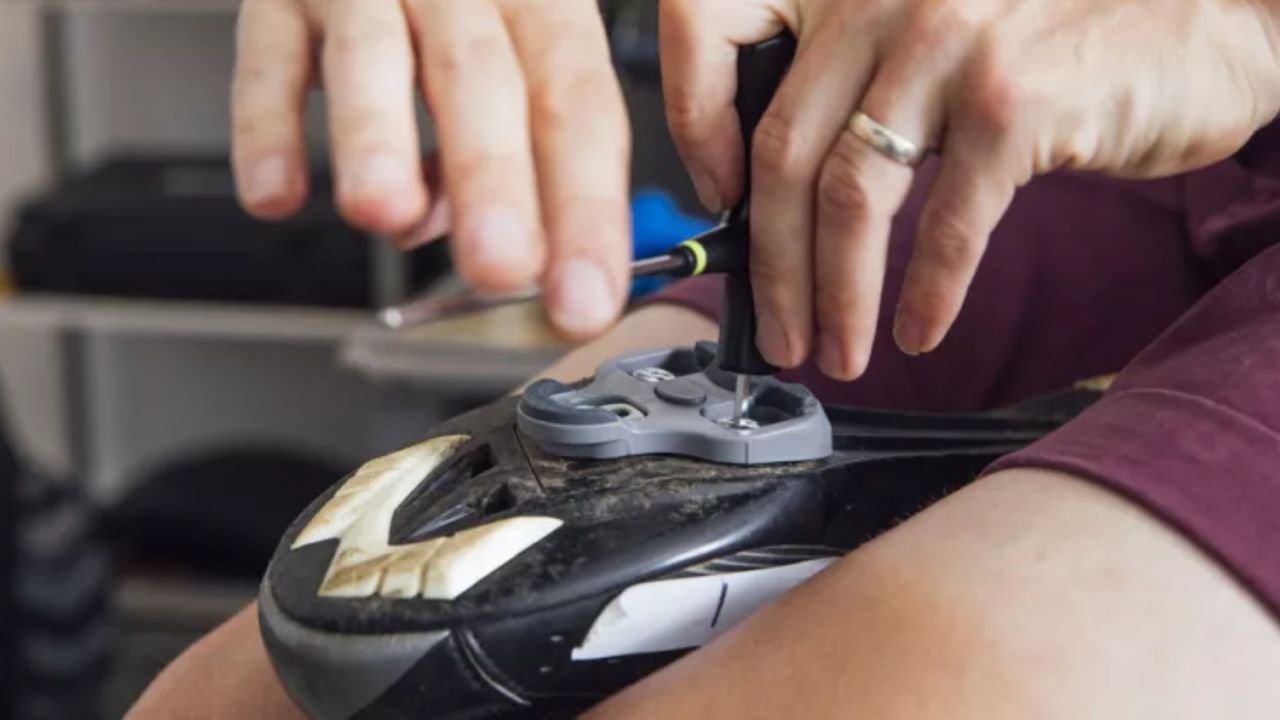
Your cleats represent one of just three contact points between you and your bike (your saddle and handlebars are the other two). And arguably, it is this contact point that is most important, as it’s through the pedals that power is transferred from your legs to the forward motion of your bike.
A set of the best clipless pedals will set you up for miles of comfortable and efficient cycling. Although many riders know how to cycle with ‘clipless’ pedals, not all of them affix their cleats to their shoes with a particular thought process. This isn’t ideal, as inappropriately placed cleats can not only cause discomfort and a reduced power output, but they can also increase the likelihood of suffering from a common cycling injury.
In cycling, the function of the foot is to provide a stable platform through which power from the lower limb and larger muscles above (glutes, hamstrings and quadriceps) can be transferred. A sub-optimally placed cleat can wreak havoc on this chain.
The best cycling shoes have a stiff carbon sole for efficient power transfer so, by taking the time to understand how to optimally place your cleats, you’ll be taking better advantage of the shoes you’ve invested in.
There are three aspects of cleat positioning:
- Fore/aft
- Medial/lateral position or stance width
- Rotation and cleat float
Although the information below refers to 3-bolt road cleats, the same principles can be applied to 2-bolt cleat systems, found on gravel bike shoes.
All you need to know about cleat positioning for cycling
How to set the fore/aft cleat position for cycling
Fore and aft refers to the forward and rearward position of the cleat on the foot. It is generally thought that the cleat should be positioned so that the centre of the pedal axis will be in line with the ball of the foot, or the metatarsal heads.
Get The Leadout Newsletter
The latest race content, interviews, features, reviews and expert buying guides, direct to your inbox!
So how do we find the optimal fore/aft cleat position for cycling?
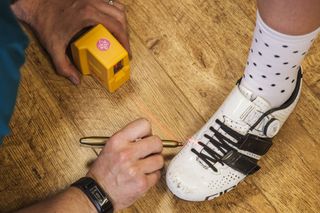
- Mark the 1st metatarsal head and 5th metatarsal head (the bump on the inside and outside of the foot) on the side of the shoe
- Draw a line across the sole of the shoe between these two marks
- Place the centre of the cleat on this line - cleats will usually have small marks on the side to indicate the centre of the cleat
Just using the 1st metatarsal (big toe) as an indicator of the ball of the foot will result in a cleat position in front of the metatarsal heads, as they run diagonally towards the 5th metatarsal.
I'm physiotherapist and bike fitter, and my tendency is to fit a more rearward position than this, often as rear as the holes drilled on the sole of the shoe will allow. Placing the cleat slightly behind the ball of the foot often decreases compression of nerves and blood vessels under the metatarsal heads, minimising the chances of foot and toe numbness. Anecdotally, many clients report this feels more powerful and stable, although research suggests there is no increase in power output with a more rearward cleat position for cycling.
Placing the cleats further back will also decrease recruitment of the calf muscles (Milour et al 2019) by reducing leverage from the ankle pivot point. The calf muscles are largely made up of fast twitch fibers, which are not ideal for stability. Moving the cleats rearward reduces their work, which is beneficial for endurance riding.
Cleat fore/aft to some extent will be determined by the type of riding the cyclist does and what they prioritise. A forward cleat position means a greater ability to change speed rapidly and accelerate (although not affecting outright top speed) - making this change could be useful for improving your sprinting, as well as crit racing and track event performance. However, this is at the expense of foot stability, the further forward the cleat is positioned towards the toes, the harder the calf muscles have to work to control and stabilise the foot owing to the lengthening lever arm.
I have encountered some riders who have set their cleats forward to avoid toe overlap. Toe overlap usually only becomes an issue when track standing or riding tight corners at low speed (such as bike paths) and is relatively normal, especially for smaller bikes with shorter wheelbases.
And finally, changing the fore/aft position of your cleat may require small changes in your saddle height and fore/aft position.
How to set lateral cleat position for cycling
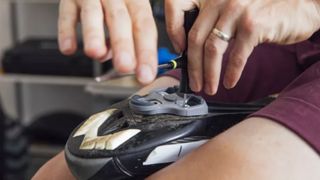
This refers to the side to side position of the cleat on the shoe, by which we can manipulate Q Factor and stance width. Ideally in cycling, we want the hip, knee and foot to operate in a straight line.
Both road and MTB cleats will have some side to side adjustment, between 4-6mm. Cleats placed towards the inside of the shoe will widen your stance width. Whilst there are numerous other ways to widen your stance width, the only way to narrow your stance width is via the cleats - moving them to the outside of the shoe.
Our stance is self-selected, influenced by posture, habit, anatomical and physical characteristics such as pelvis width, lower limb alignment or hip stiffness.
To determine whether changes will need to be made, observation of your pedalling on the bike is essential. Knees kicking out during the pedal stroke can indicate a stance width that is too narrow, knees dropping in can mean the stance width is too wide.
Cleat float and rotation position for cycling
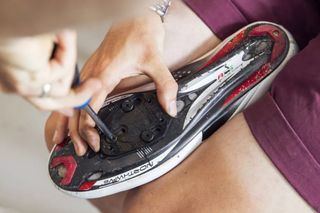
Cleat float refers to the amount of inward and outward rotation available when clipped into the pedals. Having available float in your cleat will allow you to move the foot in or out to a more natural position during the pedal stroke, allowing the knee to track in its natural plane of movement.
You never want to be at the end of your float range, as this will transmit torsional forces further up the chain. If the foot feels unstable on the pedal, the issue is not usually having too much rotation in the cleat, but rather whatever is causing the leg to operate in poor alignment. Locking the foot into position with minimal float cleats can cause pain and injury to various structures, especially the knee.
It is better to have more float and not use it, than have less float and need more. If you don’t need the float in your cleats, you often won’t notice it.
So how do I set the rotation position of my cleats? We can assess the “natural” rotation of our lower leg and feet when sitting or standing, but I find they often do not match up to what your feet do when pedalling.
I start with centre (neutral) rotation and adjust from there. Whilst pedalling, if you are pushing against the float of the cleat at any point in the pedal stroke, the cleat should be adjusted to allow more heel in or heel out movement (or the cleat changed to one with more float). Note that if more heel in rotation is needed, the cleat may also need to be moved more laterally to avoid contact with the crank.
Float is set in the cleat, not the pedal tension which is how easy it is to clip in and out of your pedals. Most brands of 3-bolt road cleats work on a self-centering mechanism and are colour coded as follows:
| Row 0 - Cell 0 | Look | Shimano | Xpedo | Time |
| 0 degrees | Black | Red | Black | Black (fixed) |
| 2 degrees | Row 2 - Cell 1 | Blue | Row 2 - Cell 3 | Row 2 - Cell 4 |
| 4.5 degrees | Grey | Row 3 - Cell 2 | Row 3 - Cell 3 | Row 3 - Cell 4 |
| 5 degrees | Row 4 - Cell 1 | Row 4 - Cell 2 | Row 4 - Cell 3 | Black (free) |
| 6 degrees | Row 5 - Cell 1 | Yellow | Red | Row 5 - Cell 4 |
| 9 degrees | Red | Row 6 - Cell 2 | Row 6 - Cell 3 | Row 6 - Cell 4 |
Speedplay cleats - found on Wahoo’s Speedplay Zero pedals and the dual-sided power meter Wahoo Powrlink Zero pedals - are the exception, allowing 0 to 15 deg of free float rotational movement. This float can be dialled in to allow different and varied amounts of heel in and heel out movement, rather than placing the cleat in a rotated position.
FAQ about cleat position for cycling
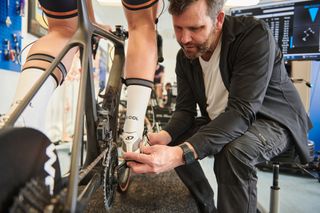
Do cleats need to be placed the same way on each foot?
Not at all. We are asymmetrical beings on a symmetrical machine, so cleat position can vary between feet, particularly if one foot is bigger than the other.
What issues might I experience from poor cleat set up?
The range is wide and varied, but some common issues include pressure, pain, numbness, tingling or hot spots in the feet, knee pain, calf overuse, and instability.
How do I replace my worn cycling cleats on my road shoes?
The easiest way is to draw around the current cleat position before removing them, preferably with a thin pen or pencil, then fitting the new cleats in exactly the same position. Changing to a different pair of shoes will likely require you or your bike fitter to refit the cleats again.

Thank you for reading 20 articles this month* Join now for unlimited access
Enjoy your first month for just £1 / $1 / €1
*Read 5 free articles per month without a subscription

Join now for unlimited access
Try first month for just £1 / $1 / €1
Nicole Oh is a physiotherapist and bike fitter, with training in biomechanical assessments, sports injury rehabilitation, acupuncture and clinical pilates.
A competitive cyclist with a background in triathlon, Nicole raced at National level in the UK, also managing and co-founding the Les Filles Racing Team. Having moved to Sydney, she works as a physiotherapist at The Body Mechanic and continues to race competitively.
-
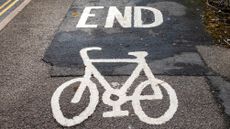 'Cycle lanes that don’t join up just make everyone look a bit stupid': Why do so many bike lanes just end?
'Cycle lanes that don’t join up just make everyone look a bit stupid': Why do so many bike lanes just end?Frustrated by bike lanes that come to an abrupt end? You're not alone
By Hannah Reynolds Published
-
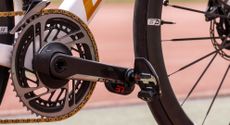 Tech of the week: Analyse every watt with Body Rocket's new power meter, step back to the 80s with Smith Ultralites and State launches super accessible updated All Road
Tech of the week: Analyse every watt with Body Rocket's new power meter, step back to the 80s with Smith Ultralites and State launches super accessible updated All RoadWorld's most accurate power meter by Body Rocket makes sure no watts are left unread, Smith gets all nostalgic with new Ultralites and State gives you a good reason to try gravel. Meanwhile, Hunt's gravel wheels win a design award.
By Cat Glowinski Published